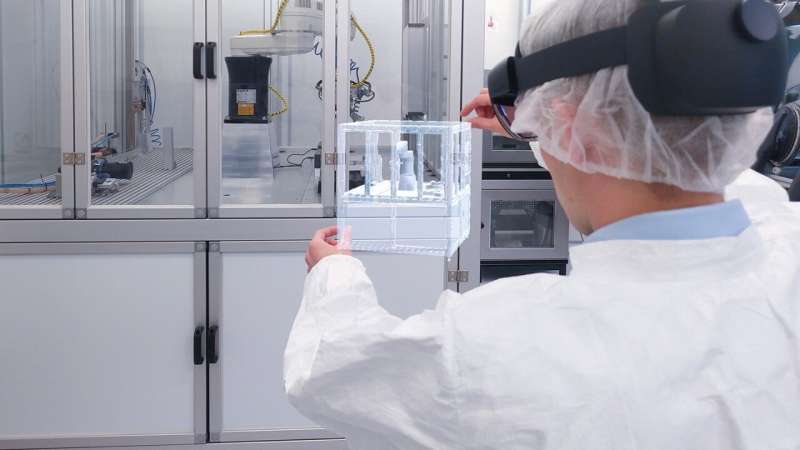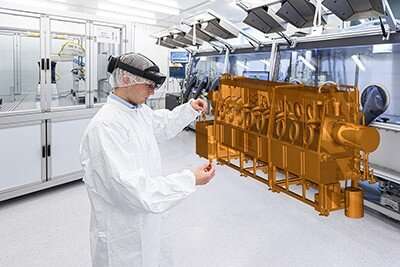Working interactively with mixed-reality factory layouts
The factories of the future have significant demands to meet—including the ability to adapt to production processes quickly and function within tight spaces that come at a high operating cost. Mixed reality can provide efficient support for factory planning in exactly this kind of scenario.
Through their HoloLayouts software, researchers at the Fraunhofer Institute for Manufacturing Engineering and Automation IPA have developed an application in which multiple people can collaborate interactively on creating factory layouts that use space efficiently. The factory planning process can be experienced in a virtual environment, with changes made live and in real time.
Today’s factories are often planned on computers. The disadvantage of this approach is that it is difficult to get production employees involved in the process since the software usually needs to be operated by an expert. However, input from production employees is an essential part of creating the right layouts and spaces.
Production processes are also evolving quickly, requiring factory buildings to be converted and extended. Battery production is a prominent example of an area in which processes are changing rapidly as a result of innovations in products and production technologies.
These challenges are what led Fraunhofer IPA’s researchers to develop an application for mixed-reality (MR) factory planning. HoloLayouts came about as part of the DigiBattPro4.0—BMBF project, whose aim is to achieve full digital transformation in the area of battery cell production.
Mixed reality: The best of all worlds
“The spaces used for battery production cost a lot to run due to the specific requirements that the processes involve, such as clean rooms and dry rooms. They’re also usually pretty scarce areas. Production innovations require versatile flexible design options in the future. The factory of the future has to be changeable,” says Christian Kaucher, a researcher at Fraunhofer IPA. “With HoloLayouts, we’re responding to this need and making a space-efficient, flexible planning possible that allow layouts to adapt quickly to new product and production technologies.”
Together with colleagues Günther Riexinger and Markus Sasalovici, and with the aid of the Unity development environment, Kaucher has managed to harness the key advantage of the mixed-reality tool: It enables multiple people to interact with one another in the process of planning a factory, something that is not generally possible in conventional computer-based 3D planning tools. In contrast to virtual reality (VR), there is no partition between the employees and the environment—alongside virtual models, they are still able to see the actual environment and can interact with other people involved in the planning process.

Fine-tuning and validating factories
This has been made possible through combining the HoloLayouts software and the hardware it requires to run, Microsoft HoloLens 2. This mixed-reality headset projects the virtual planning environment directly into users’ field of vision. Users can then pick up, move, slide, scale and position individual objects such as machines or workpieces, and a catalog is available for adding new objects. It is also possible to adjust distances between objects and aisle widths, for example.
In miniature mode, users can start by drafting a range of layout options and looking at an overview of the plan. The layouts are then displayed in their original size in 1:1 mode, allowing them to be validated on the spot. “This makes it possible to identify planning flaws early on since it gives employees a realistic view of what the factory environment plan looks like,” says Kaucher, pointing out the advantages of the two view options.
Employees can also work as a team in both modes and work on layouts together. A Shared Session can be started as a way of adding more users, either in the same space (Co-Located mode) or in multiple locations (Remote mode). Co-Located mode displays the model to all the participants at exactly the same point in the space, making it easier for them to discuss specific aspects of the layout. The application’s intuitive design means that even employees with no experience of MR can take part in the planning process.

HoloLayouts tested in initial applications involving VARTA
HoloLayouts has already proven itself in practical testing as part of the DigiBattPro4.0 project. The mixed-reality application was used to plan a new area containing two raw material supply stations for big bags and a range of peripheral devices, such as dust filters. The planning process was conducted in collaboration with VARTA Consumer Batteries GmbH & Co. KGaA, and employees particularly praised the application’s ability to provide a good understanding of the space being planned and its intuitive nature.
HoloLayouts has also been used in the Center for Digitalized Battery Cell Manufacturing (ZDB) to plan an assembly line for 21700 lithium-ion battery cells. Battery cell production comprises the processes of manufacturing electrode strips, assembling the cells using electrodes and other components, and finishing the cells. A production line was created at Fraunhofer IPA for the purpose of assembling the cells, the second of these steps. “We were able to bring HoloLayouts into play as part of this, which allowed us to create and test layouts that used the limited space available very efficiently,” says Kaucher.
Citation:
Working interactively with mixed-reality factory layouts (2023, January 3)
retrieved 3 January 2023
from https://techxplore.com/news/2023-01-interactively-mixed-reality-factory-layouts.html
This document is subject to copyright. Apart from any fair dealing for the purpose of private study or research, no
part may be reproduced without the written permission. The content is provided for information purposes only.
For all the latest Technology News Click Here
For the latest news and updates, follow us on Google News.
